Heavy Metals in Fly Ash as a Factor Limiting Its Use in Fertilizing Composts
Abstract
1. Introduction
- Approximately 30% used in agriculture;
- Approximately 23% processed by incineration;
- Approximately 16% used in landfill;
- Approximately 22% used in compost;
- Approximately 21% used in other ways (forestry, silviculture, melioration, etc.).
2. Material and Methods
3. Results and Discussion
3.1. Influence of Fly Ash on the Composting Process
3.2. Organic, Biogenic and Fertilizing Substances
3.3. Heavy Metals in Compost
3.4. Water Extracts from Compost Mass
| Indicator | Unit | Sewage Sludge | Fly Ash | Compost—Weight Proportions: Straw:Sewage Sludge:Fly Ash | [66] | ||
|---|---|---|---|---|---|---|---|
| 1:10:0 | 1:10:1 | 1:10:2 | Usual Range | ||||
| BOD5 | mg O2/L | 120 | <2 | 120 | 130 | 32 | |
| COD | mg O2/L | 1450 | <5 | 1450 | 1280 | 540 | - |
| TKN | mg/L | 973 | 2.07 ±0.21 | 314 ±0.007 | 267 | 201 | - |
| N-NO3 | mg/L | <0.89 | 0.98 ±0.1 | <0.89 | <0.89 | <0.89 | 10 |
| N-NO2 | mg/L | 5.5 | <0.02 | 0.26 | 0.32 | 0.13 | - |
| Total phosphorus | mg/L | 7.32 | 7.12 ±0.71 | >65 ±0.15 | 29 ±0.076 | 4.11 ±0.128 | - |
| P-PO4 | mg/L | 103 | 18.4 ±1.84 | 62.2 | 14.7 | 6.0 | 2 |
| Potassium | mg/L | 287 | 542 ±108 | 520 | 166 | 121 | 2 |
3.5. The Sanitary Condition of the Obtained Compost
3.6. Model of Sewage Sludge Composting Process with Ash Addition
4. Conclusions
Author Contributions
Funding
Data Availability Statement
Conflicts of Interest
References
- Gholipour, S.; Ghalhari, M.R.; Nikaeen, M.; Rabbani, D.; Pakzad, P.; Miranzadeh, M.B. Occurrence of viruses in sewage sludge: A systematic review. Sci. Total Environ. 2022, 824, 153886. [Google Scholar] [CrossRef]
- EU Council. Council Directive 91/271/EEC of 21 May 1991 concerning urban wastewater treatment. J. Eur. Commun. 1991, 34, 40. [Google Scholar]
- Bagheri, M.; Bauer, T.; Burgman, L.E.; Wetterlund, E. Fifty years of sewage sludge management research: Mapping researchers’ motivations and concerns. J. Environ. Manag. 2023, 325, 116412. [Google Scholar] [CrossRef] [PubMed]
- Bianchini, A.; Bonfiglioli, L.; Pellegrini, M.; Saccani, C. Sewage sludge management in Europe: A critical analysis of data quality. Int. J. Environ. Waste Manag. 2016, 18, 226–238. [Google Scholar] [CrossRef]
- Mininni, G.; Blanch, A.R.; Lucena, F.; Berselli, S. EU policy on sewage sludge utilization and perspectives on new approaches of sludge management. Environ. Sci. Pollut. Res. 2015, 22, 7361–7374. [Google Scholar] [CrossRef]
- Journal of Laws (2015.257). Regulation of the Minister of the Environment of 6 February 2015 on Municipal Sewage Sludge (Journal of Laws of 2015, Item 257). Available online: https://isap.sejm.gov.pl/isap.nsf/DocDetails.xsp?id=WDU20150000257 (accessed on 10 April 2023).
- Eurostat Statistics Explained. Water Statistics. 2022. Available online: https://ec.europa.eu/eurostat/statistics-explained/index.php?title=Water_statistics#Wastewater_treatment_and_disposal (accessed on 11 April 2023).
- Environment. Statistics Poland, Warsaw. 2019. Available online: https://stat.gov.pl/ (accessed on 11 April 2023).
- Rutkowska, G.; Wichowski, P.; Fronczyk, J.; Franus, M.; Chalecki, M. Use of fly ashes from municipal sewage sludge combustion in production of ash concretes. Constr. Build Mater. 2018, 188, 874–883. [Google Scholar] [CrossRef]
- Wzorek, Z. Recovery of phosphorus compounds from thermally treated waste and their use as a substitute for natural phosphorus raw materials. In Chemical Engineering and Technology Series. Monograph 356; Publishing House of the Cracow University of Technology: Cracow, Poland, 2008. [Google Scholar]
- Kasprzyk, M.; Gajewska, M.; Molendowska, S. Possibilities of phosphorus recovery from effluents, sewage sludge and ashes from sewage sludge thermal processing. Ecol. Eng. 2017, 18, 65–78. [Google Scholar]
- Journal of Laws (2015.1277). Regulation of the Minister of Economy of 16 July 2015 on the Admission of Waste to Landfills (Journal of Laws of 2015, Item 1277). Available online: https://isap.sejm.gov.pl/isap.nsf/DocDetails.xsp?id=WDU20150001277 (accessed on 10 April 2023).
- Środa, K.; Kijo-Kleczkowska, A.; Otwinowski, H. Methods of disposal of sewage sludge. Arch. J. Waste Manage. Environ. Prot. 2013, 15, 33–49. [Google Scholar]
- Rosik-Dulewska, C. Fundamentals of Waste Management; PWN: Warsaw, Poland, 2008. [Google Scholar]
- Fytili, D.; Zabaniotou, A. Utilization of sewage sludge in EU application of old and new methods—A review. Renew. Sustain. Energy Rev. 2008, 12, 116–140. [Google Scholar] [CrossRef]
- Singh, R.P.; Singh, P.; Ibrahim, M.H.; Hashim, R. Land application of sewage sludge: Physicochemical and microbial response. Rev. Environ. Contam. Toxicol. 2011, 214, 41–61. [Google Scholar] [PubMed]
- Sidełko, R.; Szymański, K. Application of dynamic bioreactorin composting process of sewage sludge. Eng. Prot. Environ. 2008, 11, 331–343. [Google Scholar]
- Saveyn, H.; Eder, P. End-of-Waste Criteria for Biodegradable Waste Subjected to Biological Treatment (Compost and Digestate): Technical Proposals; EUR 26425; Publications Office of the European Union: Luxembourg, 2013; JRC87124. [Google Scholar]
- Kacprzak, M.; Grobelak, A.; Grosser, A.; Prasad, M.N.V. Efficacay of Biosolids in Assisted Phyto-stabilization of Metalliferous Acidic Sandy Soils with Five Grass Species. Int. J. Phytoremediation 2014, 16, 593–608. [Google Scholar] [CrossRef] [PubMed]
- Bolan, N.; Kunhikrishnan, A.; Thangarajan, R.; Kumpiene, J.; Park, J.; Makino, T.; Kirkham, M.B.; Scheckel, K. Remediation of heavy metal(loid)s contaminated solis—To mobilize or to immobilize? J. Hazard. Mater. 2014, 266, 141–166. [Google Scholar] [CrossRef] [PubMed]
- Ylivainio, K.; Lehti, A.; Jermakka, J.; Wikberg, H.; Turtola, E. Predicting relative agronomic efficiency of phosphorus-rich organic residues. Sci. Total Environ. 2021, 773, 145618. [Google Scholar] [CrossRef]
- Almeida, R.F.; Queiroz, I.D.S.; Mikhael, J.E.R.; Oliveira, R.C.; Borges, E.N. Enriched animal manure as a source of phosphorus in sustainable agriculture. Int. J. Recycl. Org. Waste Agric. 2019, 8, 203–210. [Google Scholar] [CrossRef]
- Qaswar, M.; Yiren, L.; Jing, H.; Kaillou, L.; Mudasir, M.; Zhenzhen, L.; Hongqian, H.; Xianjin, L.; Jianhua, J.; Ahmed, W.; et al. Soil nutrients and heavy metal availability under long-term combined application of swine manure and synthetic fertilizers in acidic paddy soil. J. Soil Sediment 2020, 20, 2093–2106. [Google Scholar] [CrossRef]
- Yadav, A.; Gupta, R.; Garg, V.K. Organic manure production from cow dung and biogas plant slurry by vermicomposting under field conditions. Int. J. Recycl. Org. Waste Agric. 2013, 2, 21. [Google Scholar] [CrossRef]
- Risberg, K.; Cederlund, H.; Pell, M.; Arthurson, V.; Schnürer, A. Comparative characterization of digestate versus pig slurry and cow manure—Chemical composition and effects on soil microbial activity. Waste Manag. 2017, 61, 529–538. [Google Scholar] [CrossRef]
- de Melo, T.R.; Figueired, A.; Machado, W.; Filho, J.T. Changes on soil structural stability after in nature and composted chicken manure application. Int. J. Recycl. Org. Waste Agric. 2019, 8, 333–338. [Google Scholar] [CrossRef]
- Ravindran, B.; Mupambwa, H.A.; Silwana, S.; Mnkeni, P.N.S. Assessment of nutrient quality, heavy metals and phytotoxic properties of chicken manure on selected commercial vegetable crops. Heliyon 2017, 3, e00493. [Google Scholar] [CrossRef]
- Pagliari, P.H. Variety and Solubility of Phosphorus Forms in Animal Manure and Their Effects on Soil Test Phosphorus. In Applied Manure and Nutrient Chemistry for Sustainable Agriculture and Environment; He, Z., Zhang, H., Eds.; Springer: Dordrecht, The Netherlands, 2014; pp. 141–161. [Google Scholar]
- Antonkiewicz, J.; Popławska, A.; Kołodziej, B.; Ciarkowska, K.; Gambuś, F.; Bryk, M.; Babula, J. Application of ash and municipal sewage sludge as macronutrient sources in sustainable plant biomass production. J. Environ. Manag. 2020, 264, 110450. [Google Scholar] [CrossRef]
- Santana, J.M.; Fraga, S.V.B.; Zanatta, M.C.K.; Martins, M.R.; Pires, M.S.G. Characterization of organic compounds and drugs in sewage sludge aiming for agricultural recycling. Heliyon 2021, 7, e06771. [Google Scholar] [CrossRef] [PubMed]
- Song, C.; Shan, S.; Müller, K.; Wu, S.; Niazi, N.K.; Xu, S.; Shen, Y.; Rinklebe, J.; Liu, D.; Wang, H. Characterization of pig manure-derived hydrochars for their potential application as fertilizer. Environ. Sci. Pollut. Res. 2018, 25, 25772–25779. [Google Scholar] [CrossRef]
- Zhu, F.X.; Yao, Z.Y.L.; Wang, S.J.; Du, R.G.; Wang, W.P.; Chen, X.Y.; Hong, C.L.; Qi, B.; Xue, Z.Y.; Yang, H.Q. Housefly maggot-treated composting as sustainable option for pig manure management. Waste Manag. 2015, 35, 62–67. [Google Scholar] [CrossRef]
- Wang, H.P.; Zhang, Q.; Li, Y.; Ren, L.H.; Li, F.L.; Luo, T.; Weng, B.Q.; Wang, Q.Y. Effects of pyrolysis temperature on yield and physicochemical characteristics of biochar from animal manures. J. Agro-Environ. Sci. 2015, 34, 2208–2214. [Google Scholar]
- Shiba, N.C.; Ntuli, F. Extraction and precipitation of phosphorus from sewage sludge. Waste Manag. 2017, 60, 191–200. [Google Scholar] [CrossRef] [PubMed]
- Journal of Laws (2016.1987). Announcement of the Marshal of the Sejm of the Republic of Poland of 7 November 2016 on the Announcement of the Consolidated Text of the Act on Waste (Consolidated Text: Journal of Laws of 2016, Item 1987, as Amended). Available online: https://isap.sejm.gov.pl/isap.nsf/DocDetails.xsp?id=WDU20160001987 (accessed on 10 April 2023).
- Alterary, S.S.; Marei, N.H. Fly ash properties, characterization, and applications: A review. J. King Saud Univ. Sci. 2021, 33, 101536. [Google Scholar] [CrossRef]
- Roy, M.; Roychowdhury, R.; Mukherjee, P. Remediation on fly ash dumpsitesthrou bioenergy crop plantation and generation: A review. Pedosphere 2018, 28, 561–580. [Google Scholar] [CrossRef]
- Sushil, S.; Batra, V.S. Analysis of fly ash heavy metal content and disposal in three thermal power plants in India. Fuel 2006, 85, 2676–2679. [Google Scholar] [CrossRef]
- Tang, Y.; Pan, J.; Li, B.; Zhao, S.; Zhang, L. Residual and ecological risk assessment of heavy metals in fly ash from co-combustion of excess sludge and coal. Sci. Rep. 2021, 11, 2499. [Google Scholar] [CrossRef]
- Shan, G.; Li, W.; Gao, Y.; Tan, W.; Xi, B. Additives for reducing nitrogen loss during composting: A review. J. Clean. Prod. 2021, 307, 127308. [Google Scholar] [CrossRef]
- Odzijewicz, J.I.; Wołejko, E.; Wydro, U.; Wasil, M.; Jabłońska-Trypuć, A. Utilization of Ashes from Biomass Combustion. Energies 2022, 15, 9653. [Google Scholar] [CrossRef]
- Hao, X.; Benke, M.B. Nitrogen Transformation and Losses during Composting and Mitigation Strategies. Dyn. Soil Dyn. Plant 2008, 2, 10–18. [Google Scholar]
- EN 12457-4:2002 (PN-EN 12457-4:2006); Characterisation of Waste—Leaching—Compliance Test for Leaching of Granular Waste Materials and Sludges—Part 4: One Stage Batch Test at a Liquid to Solid Ratio of 10 l/kg for Materials with Particle Size below 10 mm (without or with Size Reduction). Polish Committee for Standardization: Warsaw, Poland, 2006.
- EN 15934:2012-02 (PN-EN 15934:2013-02); Sludge, Treated Biowaste, Soil and Waste—Calculation of Dry Matter Fraction after Determination of Dry Residue or Water Content. Polish Committee for Standardization: Warsaw, Poland, 2019.
- EN 15935:2021-01 (PN-EN 15935:2022-01); Soil, Waste, Treated Biowaste and Sludge—Determination of Loss on Ignition. Polish Committee for Standardization: Warsaw, Poland, 2022.
- PN-Z-15011-3:2001; Municipal Waste Compost—Determination of: pH, Organic Matter, Organic Carbon, Nitrogen, Phosphorus and Potassium. Polish Committee for Standardization: Warsaw, Poland, 2001.
- EN 13342:2000 (PN-EN 13342:2002); Characteristics of Sewage Sludge—Determination of Kjeldahl Nitrogen. Polish Committee for Standardization: Warsaw, Poland, 2002.
- EN ISO 13395:1996 (PN-EN ISO 13395:2001); Water Quality—Determination of Nitrite and Nitrate Nitrogen and Their Sum by Flow Analysis (CFA and FIA) with Spectrometric Detection. Polish Committee for Standardization: Warsaw, Poland, 2001.
- EN ISO 6878:2004 (PN-EN ISO 6878:2006); Water Quality—Determination of Phosphorus—Spectrometric Method with Ammonium Molybdate. Polish Committee for Standardization: Warsaw, Poland, 2006.
- ISO 10304-1:2007 (PN-EN ISO 10304-1:2009); Water Quality—Determination of Dissolved Anions by Ion Chromatography—Part 1: Determination of Bromides, Chlorides, Fluorides, Nitrates, Nitrites, Phosphates and Sulfates. Polish Committee for Standardization: Warsaw, Poland, 2009.
- EN ISO 11885:2010 (PN-EN ISO 11885:2009); Water Quality—Determination of Selected Elements by Inductively Coupled Plasma Optical Emission Spectrometry (ICP-OES). Polish Committee for Standardization: Warsaw, Poland, 2009.
- EN 13657:2004 (PN-EN 13657:2006); Waste Characterization—Processing for Further Determination of the Aqua Regia Soluble Elements. Polish Committee for Standardization: Warsaw, Poland, 2006.
- EN ISO 5815-1:2019 (PN-EN ISO 5815-1:2019-12); Water Quality—Determination of Biochemical Oxygen Demand After n Days (BODn)—Part 1: Dilution Method with Addition of Seed Material and Allylthiourea. Polish Committee for Standardization: Warsaw, Poland, 2019.
- ISO 15705:2002 (PN-EN ISO 15705:2005); Water Quality—Determination of Chemical Oxygen Demand Index (SP-COD)—Miniaturized Method Using Sealed Tubes. Polish Committee for Standardization: Warsaw, Poland, 2005.
- Journal of Laws (2008.119.765). Regulation of the Minister of Agriculture and Rural Development of 18 June 2008 on the Implementation of Certain Provisions of the Act on Fertilizers and Fertilization (Journal of Laws of 2008, No. 119, Item 765, as Amended). Available online: https://isap.sejm.gov.pl/isap.nsf/ByYear.xsp?type=WDU&year=2008&vol=119 (accessed on 10 April 2023).
- Grzebisz, W. Fertilization of Cultivated Plants. Part II; General Agricultural and Forestry Publishing House: Warsaw, Poland, 2015. [Google Scholar]
- Sapek, B. Soil phosphorus accumulation and release—Sources, processes, causes. Water Environ. Rural. Areas 2014, 14, 77–100. [Google Scholar]
- Nesterenko, E.O.; Krasnoperova, O.E.; Isayenkov, S.V. Erratum to: Potassium Transport Systems and Their Role in Stress Response, Plant Growth, and Development. Cytol. Genet. 2021, 55, 205. [Google Scholar] [CrossRef]
- Wińska-Krysiak, M. Calcium transporters in plants. Acta Agrophys. 2006, 7, 751–762. [Google Scholar]
- Huber, D.M.; Jones, J.B. The role of magnesium in plant disease. Plant Soil 2013, 368, 73–85. [Google Scholar] [CrossRef]
- Shaul, O. Magnesium transport and function in plants: The tip of the iceberg. Biometals 2002, 15, 307–321. [Google Scholar] [CrossRef]
- Bień, J.; Wystalska, K. Sewage Sludge—Theory and Practice; Publishing House of the Częstochowa University of Technology: Warsaw, Poland, 2011. (In Polish) [Google Scholar]
- Filipek-Mazur, B. Environmental Aspects of the Use of Fertilizers and Plant Protection Products in Agriculture; Publishing House of the University of Agriculture in Cracow: Cracow, Poland, 2011. [Google Scholar]
- Kucharski, J.; Wyszkowska, J.; Nowak, G.; Harms, H. Activity of enzymes in soil treated with sewage sludge. Pol. J. Soil Sci. 2000, 33, 29–36. [Google Scholar]
- Ma, T. Effect of Processing Conditions on Nitrogen Loss of Sewage Sludge Composting. Compost. Sci. Util. 2020, 28, 117–128. [Google Scholar] [CrossRef]
- Ayers, R.S.; Westcot, D.W. Water Quality for Agriculture; FAO Irrigation and drainage paper 29 (rev. 1); FAO: Rome, Italy, 1994. [Google Scholar]
- Budzińska, K.; Szejniuk, B.; Jurek, A. Inactivation of Ascaris suum Eggs During the Process of Sewage Sludge Composting in Piles. Annu. Set Environ. Prot. 2016, 18, 258–272. [Google Scholar]
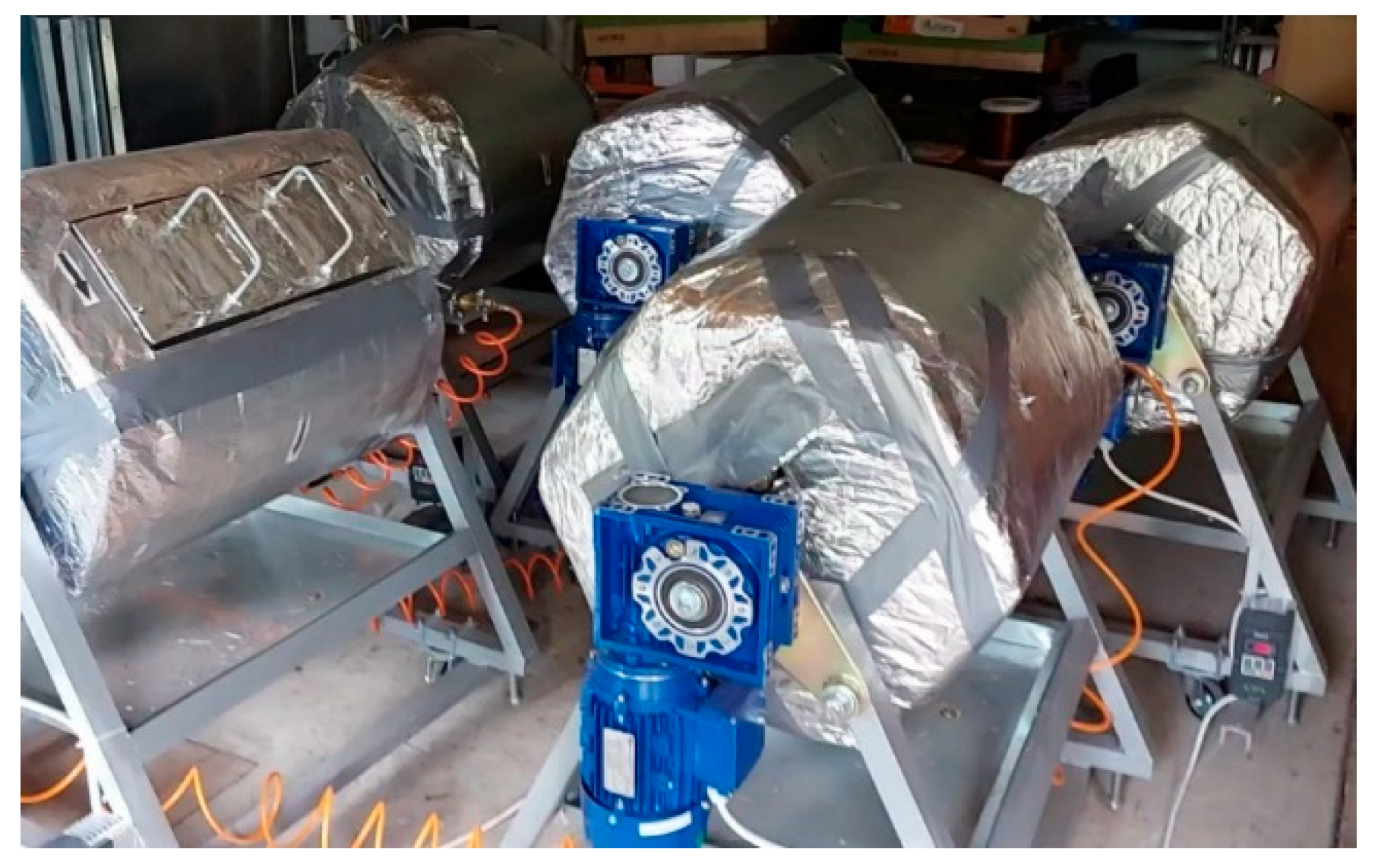
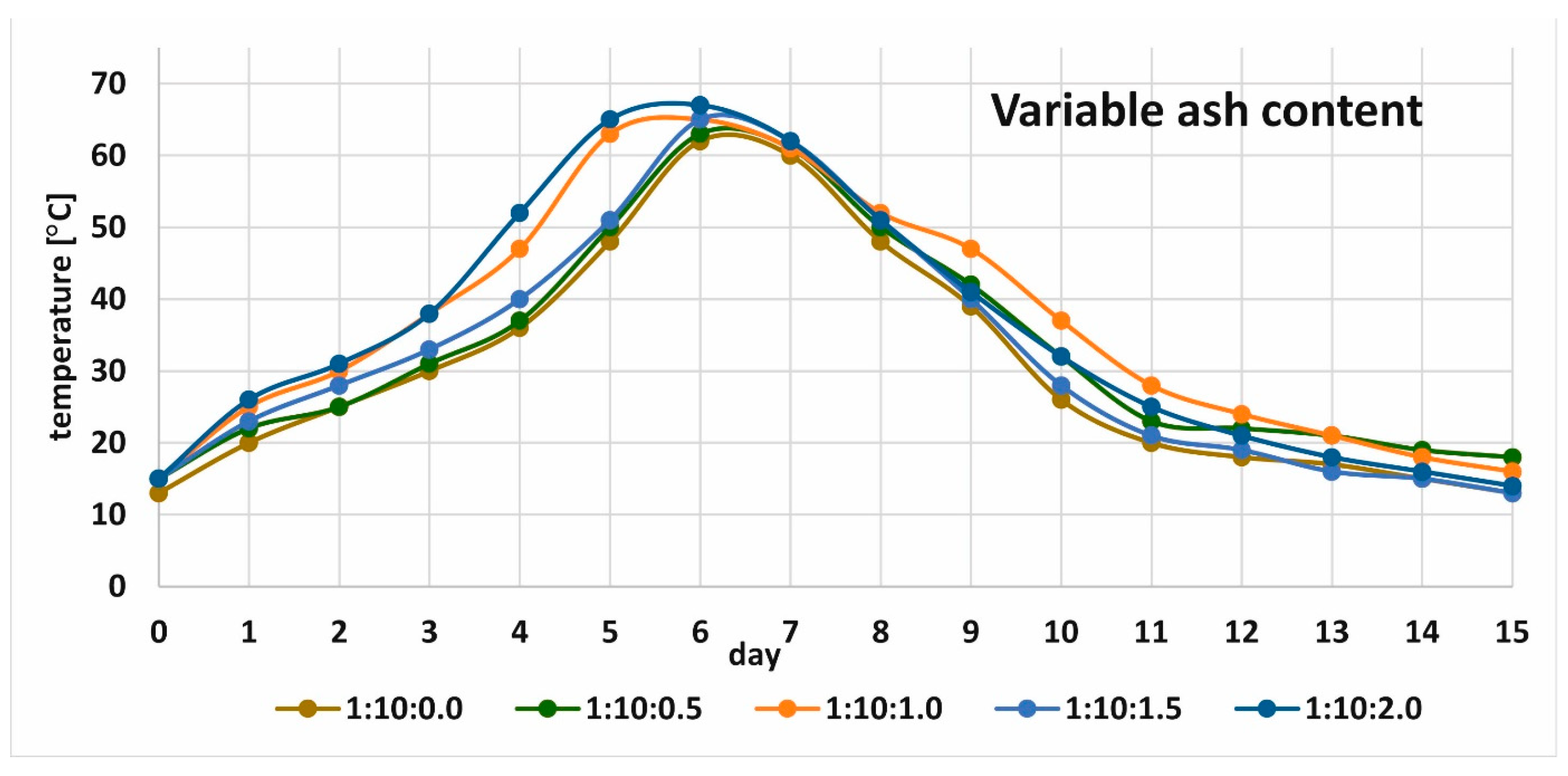
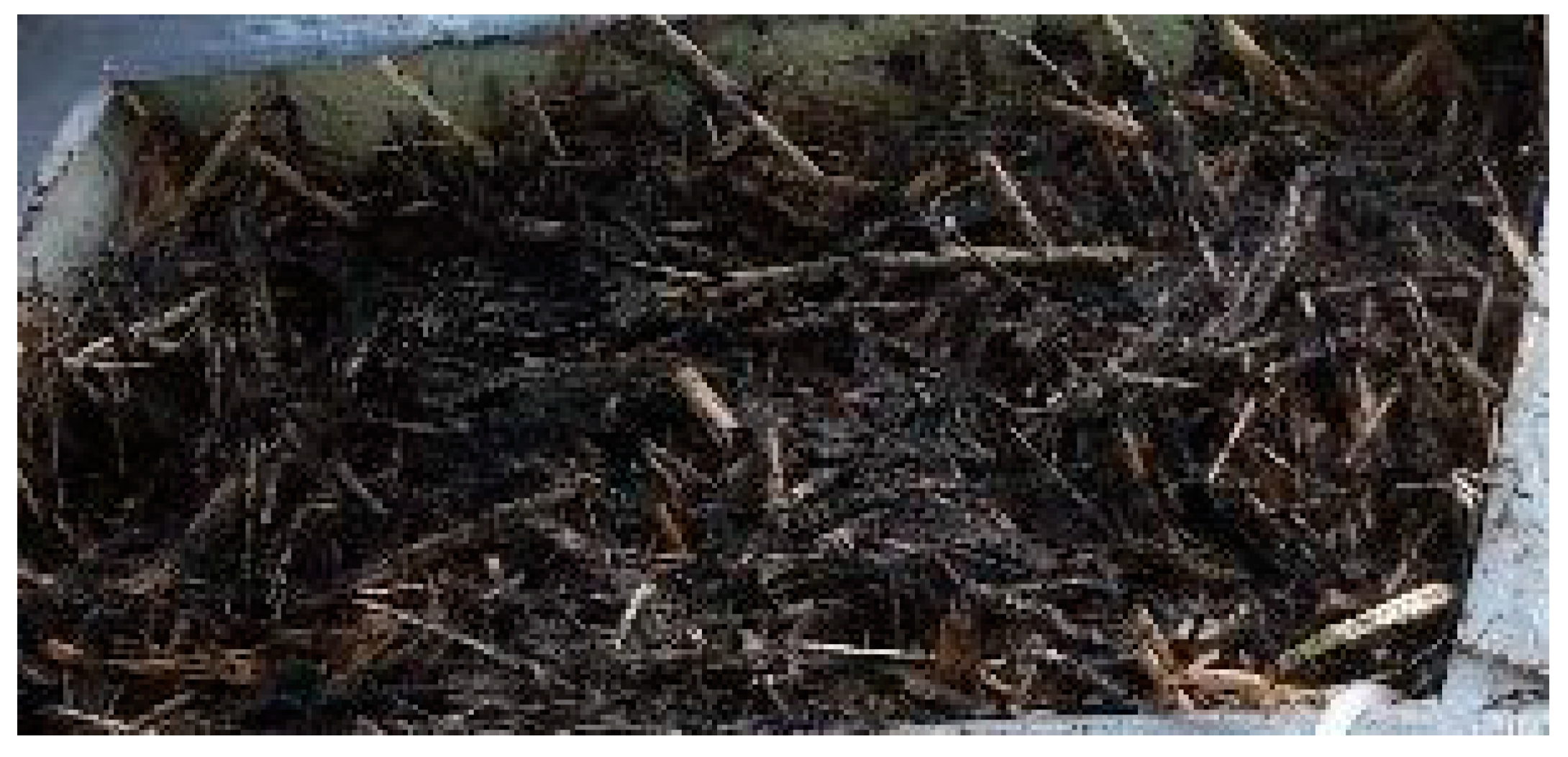
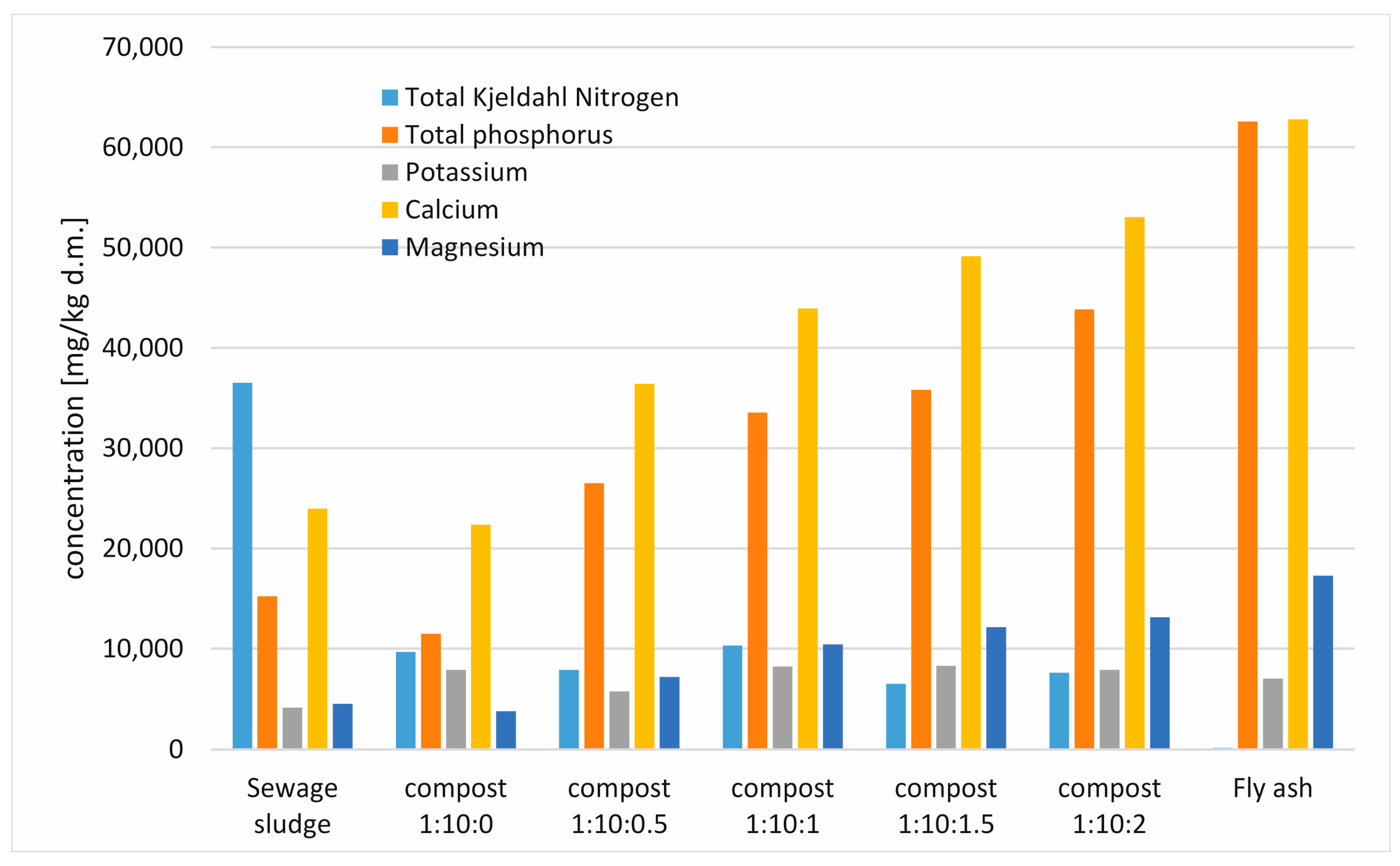
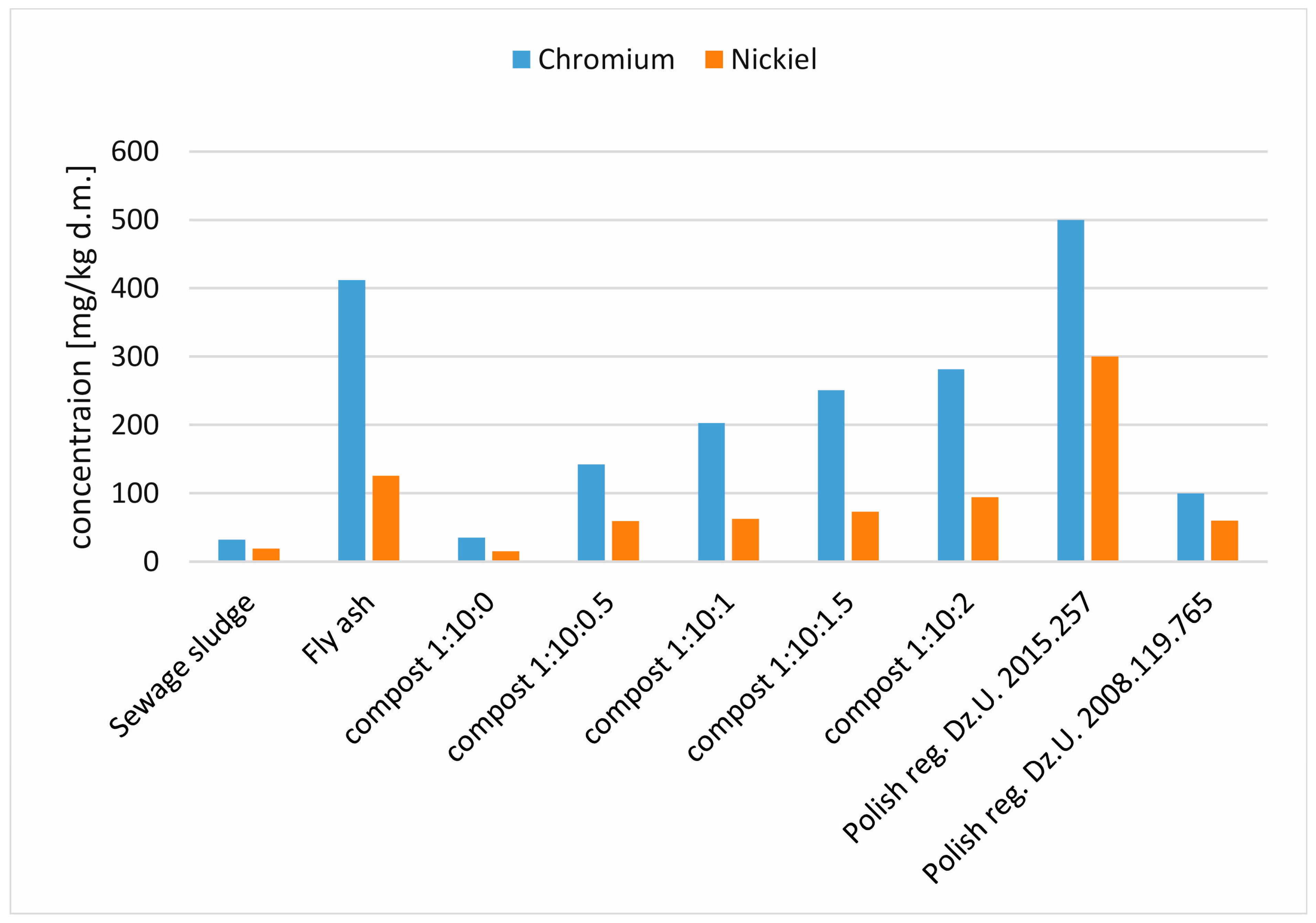
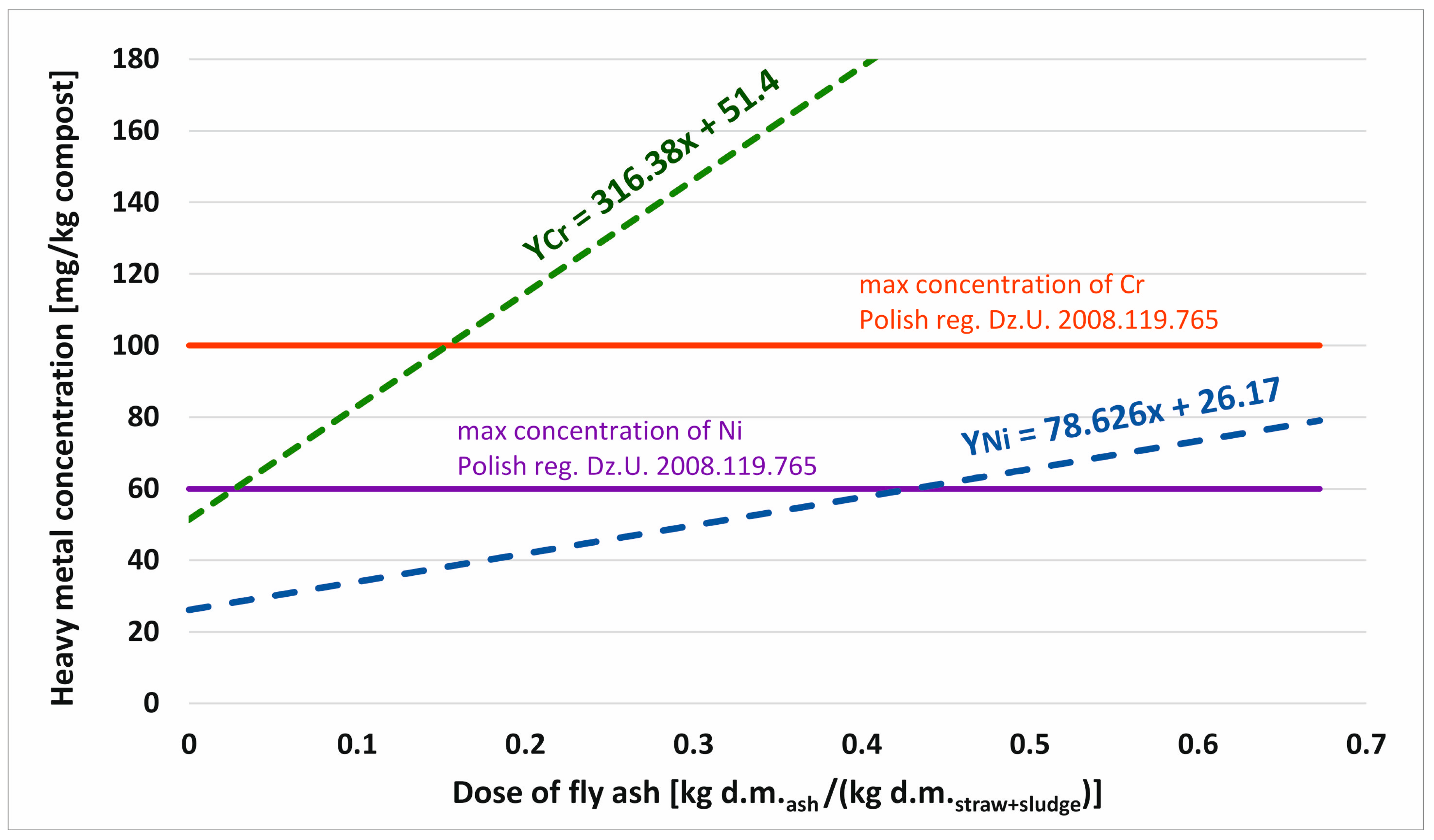
| Component | Hydration [%] | Dry Mass [%] | Dry Organic Mass [% d.m.] | Minimum Dry Mass [% d.m.] |
|---|---|---|---|---|
| Range (Average) | Range (Average) | Range | Range | |
| Raw sludge * | 91.4–92.1 (91.7) | 7.9–8.6 (8.3) | 76.9–78.8 | 21.2–23.1 |
| Stabilized sludge ** | 84.7–88.0 (87) | 12.0–15.3 (13) | 69.9–70.3 | 29.6–30.1 |
| Wheat straw | 7.6–8.6 (8) | 91.4–92.4 (92) | 92.4–93.6 | 6.4–7.1 |
| Indicator | Unit | Sewage Sludge | Fly Ash | Compost—Weight Proportions: Straw:Sewage Sludge:Fly Ash | [55] | ||||
|---|---|---|---|---|---|---|---|---|---|
| 1:10:0 | 1:10:0.5 | 1:10:1 | 1:10:1.5 | 1:10:2 | |||||
| TOC | mg/kg d.m. | 342,600 ±68,520 | <5000 - | 306,400 ±61,280 | 252,900 ±50,580 | 267,800 ±53,560 | 151,400 ±30,280 | 246,000 ±49,200 | - |
| Dry mass loss | % d.m. | 80.3 ±8.03 | <0.5 - | 74.1 ±7.4 | 54.8 ±5.5 | 47.3 ±4.7 | 35.2 ±3.5 | 36.0 ±3.6 | above 30% d.m. |
| Indicator | Unit | Sewage Sludge | Fly Ash | Compost—Weight Proportions: Straw:Sewage Sludge:Fly Ash | [6] | [55] | ||||
|---|---|---|---|---|---|---|---|---|---|---|
| 1:10:0 | 1:10:0.5 | 1:10:1 | 1:10:1.5 | 1:10:2 | ||||||
| Chromium | mg/kg d.m. | 32.4 ±4.9 | 412 ±62 | 35.0 ±5.25 | 142.0 ±21.3 | 203.0 ±30.4 | 251.0 ±37.6 | 282.0 ±42.3 | 500.0 | 100.0 |
| Chromium (water extract) | mg/L | <0.003 | 0.01 ±0.002 | 0.024 ±0.004 | <0.003 | <0.003 | ||||
| Lead | mg/kg d.m. | 30.0 ±3.0 | 107 ±11 | 27.2 ±2.7 | 58.2 ±5.8 | 64.9 ±6.49 | 76.2 ±7.6 | 81.5 ±8.2 | 750.0 | 140.0 |
| Lead (water extract) | mg/L | <0.01 | <0.01 | <0.01 | <0.01 | <0.01 | ||||
| Cadmium | mg/kg d.m. | 0.817 ±0.123 | 3.93 ±0.39 | 0.243 ±0.0364 | 2.060 ±0.309 | 1.47 ±0.22 | 1.50 ±0.225 | 2.46 ±0.369 | 20.0 | 5.0 |
| Cadmium (water extract) | mg/L | 0.021 | <0.0005 | <0.0005 | <0.0005 | <0.0005 | ||||
| Copper | mg/kg d.m. | 299.0 ±44.9 | 598 ±60 | 259.0 ±38.9 | 447.0 ±67.1 | 488.0 ±48.8 | 519.0 ±77.9 | 544.0 ±81.2 | 1000.0 | - |
| Copper (water extract) | mg/L | 0.946 | 0.214 ±0.043 | 0.384 ±0.077 | 0.242 ±0.048 | 0.254 ±0.051 | ||||
| Nickel | mg/kg d.m. | 19.3 ±2.9 | 126 ±13 | 15.2 ±2.3 | 59.7 ±8.9 | 62.5 ±9.38 | 73.0 ±10.9 | 94.3 ±14.1 | 300.0 | 60.0 |
| Nickel (water extract) | mg/L | 0.149 | 0.01 ±0.002 | 0.104 ±0.021 | 0.04 ±0.008 | 0.052 ±0.01 | ||||
| Mercury | mg/kg d.m. | 0.33 ±0.066 | 0.09 ±0.02 | 0.210 ±0.042 | 0.380 ±0.076 | 0.220 ±0.044 | 0.190 ±0.038 | 0.200 ±0.040 | 16.0 | 2.0 |
| Mercury (water extract)) | mg/L | <0.0005 | <0.0005 | <0.0005 | <0.0005 | <0.0005 | ||||
| Zink | mg/kg d.m. | 825.0 ±124 | 3159 ±474 | 828.0 ±124 | 1595.0 ±239 | 2010.0 ±302 | 2255.0 ±338 | 2346.0 ±352 | 2500.0 | - |
| Zink (water extract) | mg/L | 1.08 | 0.591 ±0.118 | 0.404 ±0.081 | 0.388 ±0.078 | 0.36 ±0.072 | ||||
| Indicator | Sewage Sludge | Fly Ash | Compost—Weight Proportions: Straw:Sewage Sludge:Fly Ash | [6] | [55] | ||||
|---|---|---|---|---|---|---|---|---|---|
| 1:10:0 | 1:10:0.5 | 1:10:1 | 1:10:1.5 | 1:10:2 | |||||
| Salmonela sp. in 100 g | not found | not found | not found | not found | not found | not found | not found | not found | not found |
| Ascaris sp. in kg d.m. | 0 | 0 | 0 | 0 | 0 | 0 | 0 | 0 | 0 |
| Trichuris sp. in kg d.m. | 0 | 0 | 0 | 0 | 0 | 0 | 0 | 0 | 0 |
| Toxocara sp. in kg d.m. | 0 | 0 | 0 | 0 | 0 | 0 | 0 | 0 | 0 |
Disclaimer/Publisher’s Note: The statements, opinions and data contained in all publications are solely those of the individual author(s) and contributor(s) and not of MDPI and/or the editor(s). MDPI and/or the editor(s) disclaim responsibility for any injury to people or property resulting from any ideas, methods, instructions or products referred to in the content. |
© 2023 by the authors. Licensee MDPI, Basel, Switzerland. This article is an open access article distributed under the terms and conditions of the Creative Commons Attribution (CC BY) license (https://creativecommons.org/licenses/by/4.0/).
Share and Cite
Malarski, M.; Wichowski, P.; Czajkowska, J. Heavy Metals in Fly Ash as a Factor Limiting Its Use in Fertilizing Composts. Water 2023, 15, 2247. https://doi.org/10.3390/w15122247
Malarski M, Wichowski P, Czajkowska J. Heavy Metals in Fly Ash as a Factor Limiting Its Use in Fertilizing Composts. Water. 2023; 15(12):2247. https://doi.org/10.3390/w15122247
Chicago/Turabian StyleMalarski, Maciej, Piotr Wichowski, and Justyna Czajkowska. 2023. "Heavy Metals in Fly Ash as a Factor Limiting Its Use in Fertilizing Composts" Water 15, no. 12: 2247. https://doi.org/10.3390/w15122247
APA StyleMalarski, M., Wichowski, P., & Czajkowska, J. (2023). Heavy Metals in Fly Ash as a Factor Limiting Its Use in Fertilizing Composts. Water, 15(12), 2247. https://doi.org/10.3390/w15122247







